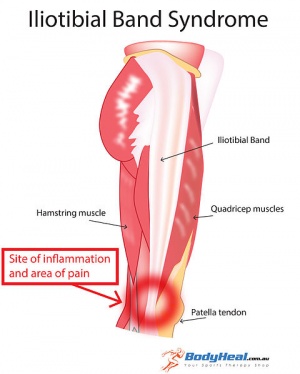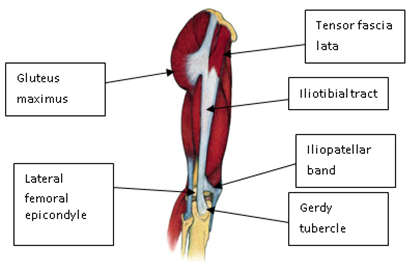Noble's test: Difference between revisions
No edit summary |
No edit summary |
||
| Line 26: | Line 26: | ||
The purpose of this test is to detect pain, abnormalities, tightness of the iliotibial tract, which can be indicative for the iliotibial band syndrome. It helps to differentiate [[Iliotibial Band Syndrome|iliotibial band syndrome]] from other common causes of lateral knee pain.<ref name="Noble 1979" /><ref name="Dubin 2005" /><br> | The purpose of this test is to detect pain, abnormalities, tightness of the iliotibial tract, which can be indicative for the iliotibial band syndrome. It helps to differentiate [[Iliotibial Band Syndrome|iliotibial band syndrome]] from other common causes of lateral knee pain.<ref name="Noble 1979" /><ref name="Dubin 2005" /><br> | ||
== Technique == | == Technique<ref name=":0" /> == | ||
Procedure: The patient is supine or side-lying with the injured side up. Grasp just above the ankle and slowly bend the knee back and forth several times from 0-90° while palpating and applying firm pressure on the lateral epicondyle of the femur for crepitus with the thumb of the other hand. This is repeated in part 2 while applying firm pressure with the thumb over the ITB just above the lateral epicondyle (Magee 2002). | Procedure: The patient is supine or side-lying with the injured side up. Grasp just above the ankle and slowly bend the knee back and forth several times from 0-90° while palpating and applying firm pressure on the lateral epicondyle of the femur for crepitus with the thumb of the other hand. This is repeated in part 2 while applying firm pressure with the thumb over the ITB just above the lateral epicondyle (Magee 2002). | ||
| Line 35: | Line 35: | ||
== Evidence == | == Evidence == | ||
Reliability & Validity: Unknown<ref>Knee Orthopaedic Test - A Strategic Approach to Assessing the Knee; University of Western States, College of Chiropractic, Clinic Protocol; Renne; Page No.34; Adopted 12/12. (accessed on 21.07.18 from Knee_Orthopedic_Tests.pdf)</ref> | Reliability & Validity: Unknown<ref name=":0">Knee Orthopaedic Test - A Strategic Approach to Assessing the Knee; University of Western States, College of Chiropractic, Clinic Protocol; Renne; Page No.34; Adopted 12/12. (accessed on 21.07.18 from Knee_Orthopedic_Tests.pdf)</ref> | ||
== Clinical Bottom Line == | == Clinical Bottom Line == | ||
Revision as of 08:37, 21 July 2018
Original Editors - Merlin Roggeman
Top Contributors - Evan Thomas, Vidya Acharya, Merlin Roggeman, Admin, Kim Jackson, Chelsea Mclene, WikiSysop, Rachael Lowe, Oyemi Sillo, Kai A. Sigel, Wanda van Niekerk, 127.0.0.1 and Demol Yves
Definition/Description[edit | edit source]
The Noble’s test (also known as Noble's Compression test) is a provocative test of the iliotibial band, developed by Clive Noble. It is commonly used as an indication for iliotibial band syndrome; however, no evidence-based research has been done yet to control the validity of this test. Other tests that could be used are the modified Ober’s test and the Renne Creak test. [1][2][3]
Clinically Relevant Anatomy[edit | edit source]
Relevant anatomy related to the test is knowledge of the iliotibial band. It starts as the iliotibial tract, which is a thickening of the fascia lata, originating from the iliac crest. The iliotibial tract continues downward, laterally from the femur. At the greater trochanter, fibres of the tensor fascia lata muscle and gluteus maximus muscle inserts in the iliotibial tract. When approaching the knee joint, the iliotibial tract passes the lateral epicondyle of the femur and splits into two structures: the iliopatellar band, and a distal extension inserting at the Gerdy tubercle (Figure 1).[4]
During walking and running, the Iliotibial band is subjected to frictional and compressive forces over the greater trochanter and lateral epicondyle. Repetitive strain, improper footwear, lower extremity mal-alignments and muscle imbalance results into increased friction.[5]
Iliotibial band (ITB) friction syndrome is an overuse injury common in runners, cyclists, weightlifters, skiers, and soccer players. It is characterized by pain over the lateral femoral epicondyle caused by excessive friction between the ITB and the lateral femoral epicondyle.
Purpose[edit | edit source]
The purpose of this test is to detect pain, abnormalities, tightness of the iliotibial tract, which can be indicative for the iliotibial band syndrome. It helps to differentiate iliotibial band syndrome from other common causes of lateral knee pain.[2][4]
Technique[6][edit | edit source]
Procedure: The patient is supine or side-lying with the injured side up. Grasp just above the ankle and slowly bend the knee back and forth several times from 0-90° while palpating and applying firm pressure on the lateral epicondyle of the femur for crepitus with the thumb of the other hand. This is repeated in part 2 while applying firm pressure with the thumb over the ITB just above the lateral epicondyle (Magee 2002).
Interpretation: Palpable snapping, rubbing or “squeaky hinge-like” crepitus or localized pain that increases with pressure at or above the epicondyle (often at 30° of flexion) indicates ITB syndrome.
Evidence[edit | edit source]
Reliability & Validity: Unknown[6]
Clinical Bottom Line[edit | edit source]
This test is indicative of iliotibial band syndrome, but again it must be stated that there have been no studies to indicate the validity of this test.[2][4]
References[edit | edit source]
- ↑ Kasunich NJ. Changes in low back pain in a long distance runner after stretching the iliotibial band. Journal of Chiropractic Medicine 2003; number 1, volume 2; 37-40. http://www.ncbi.nlm.nih.gov/pmc/articles/PMC2646955/pdf/main.pdf (accessed 20/05/2011) LEVEL OF EVIDENCE: B
- ↑ 2.0 2.1 2.2 Noble CA. The Treatment of Iliotibial Band Friction Syndrome. Brit. J. Sports Med. 1979; 13; 51-54. http://www.ncbi.nlm.nih.gov/pmc/articles/PMC1859686/pdf/brjsmed00261-0005.pdf (accessed 20/05/2011) LEVEL OF EVIDENCE: A2
- ↑ Rosenthal MD. Clinical Testing for Extra-Articular Lateral Knee Pain. A Modification and Combination of Traditional Tests. North American Journal of Sports Physical Therapy 2008; volume 3, number 2; 107-109. http://www.ncbi.nlm.nih.gov/pmc/articles/PMC2953323/pdf/najspt-03-107.pdf (accessed 20/05/2011) LEVEL OF EVIDENCE: B
- ↑ 4.0 4.1 4.2 4.3 Dubin J. Evidence Based Treatment for Iliotibial Band Friction Syndrome: Review of Literature. BioMechanics, August 2005. http://dubinchiro.com/iliotibial_band.pdf (accessed 22/05/2011) LEVEL OF EVIDENCE: A1
- ↑ SieunNarine-McKay J. Evaluation of outcomes in assessment of iliotibial band syndrome rehabilitation programs (Doctoral dissertation, University of British Columbia).https://open.library.ubc.ca/cIRcle/collections/ubctheses/24/items/1.0306928 (accessed on 21/07/2018)
- ↑ 6.0 6.1 Knee Orthopaedic Test - A Strategic Approach to Assessing the Knee; University of Western States, College of Chiropractic, Clinic Protocol; Renne; Page No.34; Adopted 12/12. (accessed on 21.07.18 from Knee_Orthopedic_Tests.pdf)
- ↑ Physiotutors. Noble Compression / Noble's Test | Iliotibial Band Friction Syndrome ITBS. Available from: https://www.youtube.com/watch?v=PmUGl7ryQOo








